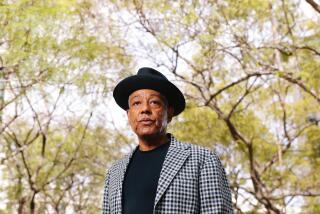‘The Rite’ is based on a real priest trained in exorcism
- Share via
For the last four years, Father Gary Thomas has served at the Sacred Heart parish in Saratoga, Calif., a bucolic suburb of San Jose. But the 53-year-old Roman Catholic priest does a lot more than say Mass and listen to confessions — he is also one of about 14 Vatican-certified exorcists working in the U.S. and the real-life counterpart to the character played by newcomer Colin O’Donoghue in the new thriller “The Rite,” which opens Friday.
Thomas became certified to practice exorcisms after completing 40 hours of study at the Vatican’s Athenaeum Pontificium Regina Apostolorum in Rome. During his time there, he met a fellow student, journalist Matt Baglio, who ended up chronicling Father Gary’s journey in the book “The Rite: The Making of a Modern Exorcist,” which served as the basis for the film.
“I believe in the personification of evil,” Thomas said.
O’Donoghue plays Michael Kovak, a skeptical seminarian sent to Rome to become an exorcist who ends up hooking up with an eccentric Welsh priest, Father Lucas (Anthony Hopkins), who performs exorcisms. Kovak ultimately must perform an exorcism on his mentor when Satan takes possession of the elderly cleric after one of his subjects — a demonically possessed young woman (Marta Gastini) who’s carrying her own father’s child — dies.
Thomas spent a week on the set of the movie, serving as an advisor to the film from director Mikael Hafstrom (“1408”). He drew on much of the personal experience for the consulting job; in the last four years, he has seen about 100 people who felt that they were possessed by the devil.
“I have exorcised five,” he said. “There are probably another two or three or four who I have been praying over regularly.”
Just as is the case with the young woman in the film, Thomas says that 80% of the people who come to him have been physically or sexually abused. Every time he’s called about a person who might be possessed, he asks what kind of help the individual already has received. If he agrees to a meeting, he sits with the person for an interview about how the “demonic attachment” began and asks questions about family history. “A lot of times it is mental health [issues],” he acknowledges.
If Thomas determines the person has a demonic attachment, he has a number of methods to free him or her before resorting to an exorcism. “You never try that first,” Thomas says. “You use other means of protection — sacraments, prayer, the Eucharist. What you want the person to do is say [the demon is] not welcome, it is not wanted, so go away. The person cooperates by staying close to God through prayer, through the sacraments.”
The best way to agitate a demon, Thomas says, is to pray over the subject; the person’s face, he explains, will begin to distort as the demon manifests itself, something that the filmmakers utilized for a sequence in “The Rite.”
“There is a point when Anthony Hopkins, you see his head look very unnatural in the way it is turning,” Thomas said. “That’s very normal. When you pray you hurt the demon, and the demon oftentimes will manifest itself in a very serpentine way.”
Thomas recalled an occasion when he was visited by a young Venezuelan woman who had been involved in palm readings for several years. “I was beginning to do some deliverance prayers. Within a few minutes she began to tremor and her facial countenance began to change. You saw a snake. She began sticking her tongue out like a snake and hissing and rolling her eyes. She coiled herself up.
“Her mother and father began to restrain her a bit. I went to get the Eucharist. The woman almost jumped out the window [at the sight of the Eucharist]. Her parents held her down. One minute you could see the demon, the next minute it was her. She kind of came back. I said, ‘Can you take the Eucharist?’ She said, ‘I’m not sure, but I’ll try.’ As I offered it to her, she resisted. I said, ‘Just open your mouth.’ All I had to wash it down was holy water.”
More to Read
The biggest entertainment stories
Get our big stories about Hollywood, film, television, music, arts, culture and more right in your inbox as soon as they publish.
You may occasionally receive promotional content from the Los Angeles Times.











